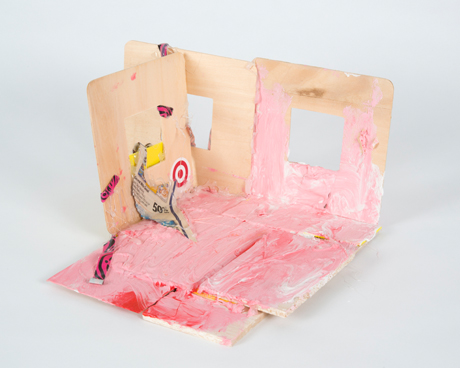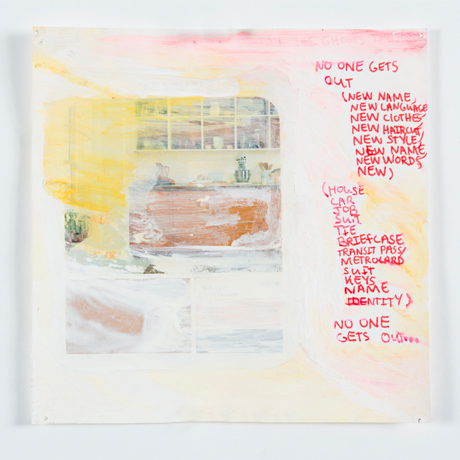Thesis Exhibition: April 19- April 22, 2017
Opening Reception : April 21, 6-8pm

Target (Bulls-Eye)
Wood, paper materials, acrylic paint and mediums, tape. Height 10.5 inches, width 11.5 inches, depth 6.5 inches. 2015.

It's Not Over Paper, paper materials, acrylic paints and mediums, ink, gouache paint. Height 8 inches, width 8 inches. 2015.
I am interested in creating installations that evoke fragmented, haunted narratives. Through the combination of works on paper with constructed/deconstructed houses, my work explores themes of absence, presence, dislocation and displacement. Drawn, painted and photographic images combined with text and three-dimensional tabletop dioramas suggest both an internal and external landscape of distorted time and place.
Archival process is very important to me. Although my work looks as if it can fall apart at any moment, its aspect of fragility is an aesthetic choice. I go through a process of photocopying news media (using high quality Epson inks which are guaranteed to last a minimum of 100 years) onto archival acid free paper, which is then coated with high quality Liquetex/Golden acrylic mediums. The piece is then painted with high quality archival Holbein Gouache paint and/or Golden Acrylic paint.
My film slides are made from my black and white digital photographs and from digital images of my works on paper. I have also altered the slides made from works on paper by scratching out parts and re-painting them with ink, gouache, and acrylic mediums.
I made original black and white images by blocking off part of the viewfinder of the camera by using another lens and/or a piece of paper (so that the camera only sees—and then captures—a select sliver of the frame); the rest of the scene that would normally be in the image captured by the camera is organically cropped out.
I shoot my digital images in black and white and manually change aperture/ISO sensitivity, in camera while shooting, in order to produce exaggerated lights and shadows.
These images are mostly street scenes from the Soho neighborhood of New York City that I photographed to look like archival surveillance photos (and in particular archival surveillance photos from outside of the USA). They are meant to be fragments from a far-away place (and a different era).
The film slides are displayed using a slide projector. I find this process interesting because the narrative moves backwards through time. A digital image is transformed into a film slide. The image is plucked from the contemporary and changed into an image that exists in the past. In contrast, usually the discourse of images involves moving images from older mediums (slides, film…) to present day mediums (digital, online...)
There is also something very arresting about the fact that instead of seeing an object (i.e. a painted 2D work on paper) you are seeing a ghost of an object (i.e. a projected image of a 2D work on paper). This is because one is seeing the representation of the object (the 2D work on paper) through the slide projector but the object itself is not really there; one is just seeing light and shadow particles that are arranged in a certain way upon a blank wall.
While there is a nostalgia factor to using an analog slide projector, that is not my primary goal. The warmth of analog (non-digital) light in a slide projector is fundamentally different than the cool ‘digital’ (pixel) light of a digital slide projector. It is important that my slide images be viewed through a warm film projector light because warm light heightens their ghostliness and cool digital light sanitizes them. There is a certain scientific detachment that orderly pixelated blue light gives images which puts them in the realm of computers and online media (and thus by extension the realm of ‘science’ and the ‘rationality’ and ‘logic’ of science and scientific thought). I do not want that.
These works belong in the realm of irrationality and in an older pre-/non- scientific sphere. These slides are of the world of spirits and ghosts. They are about something much older than daytime logic. They are the dreams and superstitious knowledge that people turn to when rationality stops.
My work (whether it is 2D, 3D, or photographic) reflects how I see the world and how I see America. America is dystopian because there is an undercurrent of structural instability, inequality, and repression that has always existed. I think skulls are of particular interest and importance because they are a symbol of death—literally and figuratively—and the United States society and societies globally are built on bones. The inclusion of skulls is an important (though subtle) political reminder that life is being built upon death.
Artwork reflects its creator and its creator’s relationship to history. My work has a different perspective and anxiety than that of someone who has always felt a sense of belonging. My work is, at its core, fundamentally different from the type of artwork made by someone whose history has not been erased.